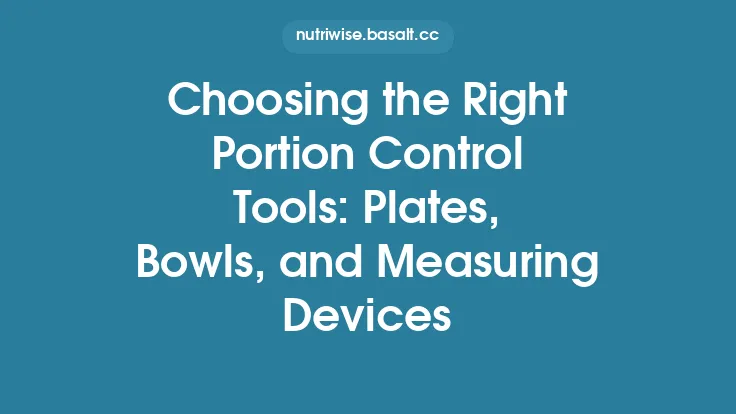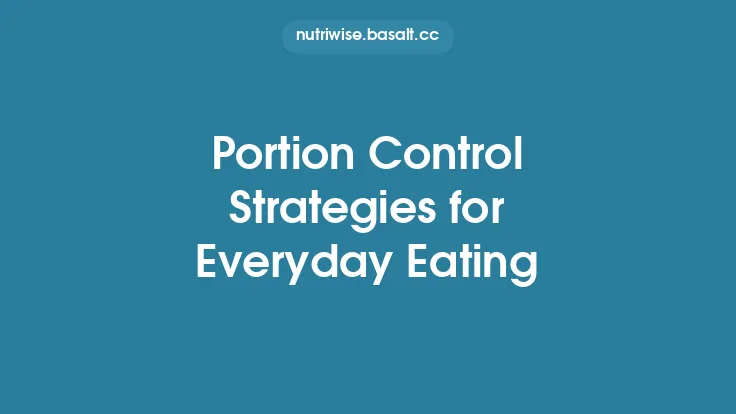Portion control is more than just a diet‑centric buzzword; it is a cornerstone of sustainable eating that directly curtails plate waste. When the amount of food served aligns with actual consumption, fewer leftovers end up in the trash, reducing the environmental footprint of every meal. This article delves into the science of portion sizing, practical tools for the home kitchen, systematic approaches for food‑service operations, and behavioral strategies that help individuals and institutions serve just the right amount—every time.
Understanding the Relationship Between Portion Size and Plate Waste
Portion size vs. serving size
- *Portion size refers to the amount of food placed on a plate, while serving size* is the recommended amount of a particular food that contributes to a balanced diet. Confusing the two often leads to over‑portioned plates, which in turn generate waste.
The “portion distortion” phenomenon
- Over the past few decades, average portion sizes in restaurants and packaged foods have increased by up to 30 % in many Western countries. This upward shift recalibrates our perception of “normal,” prompting diners to consume more than they need and discard the excess.
Quantifying waste
- Studies using plate‑waste audits (weighing leftovers before disposal) consistently show a linear relationship: a 10 % increase in portion size can raise plate waste by 5–8 %. Understanding this metric helps set realistic targets for waste reduction.
Visual Portion‑Control Strategies
The “hand” method
- Protein: Palm‑sized portion (≈ 3 oz for meat, fish, tofu).
- Starches: Fist‑sized portion (≈ ½ cup cooked grains, pasta, or potatoes).
- Vegetables: Two‑hand‑wide portion (≈ 1 cup raw or cooked).
- Fats & oils: Thumb‑sized portion (≈ 1 tsp).
These visual cues are quick, equipment‑free, and adaptable across cuisines.
Plate‑size manipulation
- Using smaller plates (23 cm diameter) can create the illusion of a fuller plate, encouraging satisfaction with less food. Research shows that a 10 % reduction in plate size can cut intake by 5–15 % without affecting perceived fullness.
Color contrast and portion perception
- Placing a high‑contrast garnish (e.g., a bright herb sprig) at the edge of a dish can make the portion appear larger, reducing the urge to add more. Conversely, a monochrome plate can make a modest serving look insufficient, prompting over‑serving.
Measuring Tools and Technologies
Digital kitchen scales
- Weighing food to the nearest gram eliminates guesswork. For bulk items (rice, beans, nuts), pre‑weighing portions into reusable containers streamlines cooking and serving.
Portion‑control scoops and ladles
- Standardized scoop sizes (e.g., ¼ cup, ½ cup) are inexpensive, dishwasher‑safe, and ideal for repetitive tasks like ladling soups or portioning cereal.
Smart kitchen appliances
- Modern multi‑cooks and sous‑vide devices often feature built‑in portion presets. For example, a sous‑vide circulator may allow you to set a target weight for a piece of fish, automatically adjusting cooking time and temperature.
Mobile apps for tracking
- Apps that log portion sizes via barcode scanning or manual entry can generate weekly waste reports, highlighting patterns (e.g., “extra ½ cup of rice per dinner”) and prompting corrective action.
Menu Engineering for Restaurants and Cafeterias
Standardized recipes
- Developing a master recipe with exact gram‑level ingredient specifications ensures each dish is produced consistently, preventing “chef‑to‑chef” variation that can lead to oversized servings.
Modular plating
- Designing dishes with interchangeable components (e.g., a base grain, a protein module, a vegetable side) allows staff to assemble plates that match the diner’s appetite, rather than a one‑size‑fits‑all plate.
Dynamic portion sizing
- Offering “small,” “regular,” and “large” options with clear nutritional information empowers guests to choose a portion that aligns with their hunger level.
Plate‑waste monitoring
- Implementing a simple waste‑audit system—collecting and weighing leftovers from a sample of plates each week—provides data to fine‑tune portion standards.
Training staff on visual cues
- Front‑of‑house staff can be taught to recognize signs of satiety (e.g., slower eating pace, reduced utensil activity) and suggest portion adjustments before the meal is completed.
Behavioral Nudges for Home Cooks
Pre‑portioning snacks
- Instead of eating directly from a large bag, divide snacks into single‑serve containers (≈ 30 g for nuts, 150 g for fruit). This reduces mindless over‑consumption and subsequent waste.
The “pause‑and‑assess” rule
- After plating, wait 2–3 minutes before starting to eat. This short pause allows the brain to register fullness cues, often leading to a decision to set the plate aside earlier.
Mindful eating practices
- Chewing each bite 20–30 times and putting down utensils between bites can extend meal duration, enhancing satiety signals and reducing the likelihood of finishing an oversized portion.
Portion‑size labeling at home
- Label reusable containers with the recommended serving weight for common foods (e.g., “1 cup cooked quinoa = 185 g”). Visual reminders keep portion norms top‑of‑mind during meal prep.
Batch‑size awareness
- When cooking for a family, calculate the exact number of servings needed (e.g., 4 × 150 g of chicken) and avoid the “cook extra for leftovers” mindset unless leftovers are intentionally planned and stored properly.
Cultural and Dietary Considerations
Adapting traditional dishes
- Many cultural cuisines feature communal platters. To maintain authenticity while controlling waste, serve a central “family” portion and allow diners to plate their own servings, using the hand‑method or small serving bowls.
Special dietary needs
- For low‑calorie, low‑sodium, or high‑protein diets, precise portioning is critical. Using calibrated measuring cups or a scale ensures that therapeutic diets meet nutritional targets without excess.
Age‑specific portions
- Children’s portion sizes are typically ½ to ¾ of adult servings. Providing child‑specific plates (smaller diameter) and portion tools helps avoid over‑serving and the resulting waste.
Allergen management
- Accurate portioning reduces cross‑contamination risk. For example, measuring a single‑serve scoop of a nut‑free dessert ensures that no unintended allergen residue is introduced.
Institutional Policies and Incentives
Portion‑size guidelines
- Schools, hospitals, and corporate cafeterias can adopt evidence‑based portion standards (e.g., USDA MyPlate recommendations) and embed them into procurement contracts.
Incentivizing waste‑reduction
- Offering discounts for choosing “half‑portion” meals or providing reusable “to‑go” containers for unfinished plates encourages diners to self‑regulate portion size.
Feedback loops
- Digital kiosks that ask diners to rate satiety after a meal can feed data back to kitchen staff, prompting real‑time adjustments to portion sizes.
Regulatory frameworks
- Some municipalities have introduced “portion caps” for high‑waste items (e.g., limiting soft‑drink servings to 12 oz). While controversial, such policies can drive industry‑wide reform in portion norms.
Tracking and Analyzing Plate Waste
Weight‑based waste audits
- Collect leftover plates in a designated bin, weigh them daily, and categorize by food type (protein, starch, veg). This granular data reveals which components are most over‑served.
Statistical process control (SPC)
- Apply SPC charts to monitor waste trends over time. A sudden spike may indicate a recipe change or a seasonal shift in appetite, prompting a review of portion standards.
Key performance indicators (KPIs)
- Common KPIs include “percentage of plate waste per meal” (target ≤ 5 %) and “average portion deviation from standard” (target ≤ 2 %). Regular reporting keeps waste reduction on the organizational agenda.
Continuous improvement cycles
- Use the Plan‑Do‑Check‑Act (PDCA) framework: plan new portion guidelines, implement them, check waste data, and act by refining portions further.
Integrating Portion Control with Broader Sustainability Goals
Resource efficiency
- Reducing plate waste directly lowers the demand for agricultural inputs (water, fertilizer, land) because fewer foods are produced only to be discarded.
Carbon footprint reduction
- Every gram of food saved from waste avoids the embedded greenhouse‑gas emissions associated with its production, processing, and transport.
Economic benefits
- Households can save 10–15 % on grocery bills by serving appropriate portions, while food‑service operators can improve profit margins by purchasing less raw material and decreasing waste disposal costs.
Social equity
- Efficient portioning can free up surplus food for donation programs, aligning waste reduction with community food‑security initiatives.
Practical Take‑aways
- Adopt visual portion cues (hand method, plate size) for quick, everyday use.
- Invest in simple measuring tools—a digital scale and standardized scoops—to eliminate guesswork.
- Implement waste‑tracking in both home and commercial settings to identify over‑served items.
- Educate staff and family members on portion norms and mindful eating practices.
- Leverage technology (smart appliances, apps) to automate portion control where possible.
- Align portion policies with broader sustainability metrics to reinforce the environmental impact of each saved gram.
By embedding these techniques into daily routines and institutional practices, we can dramatically shrink plate waste, conserve resources, and move toward a more sustainable, ethical food system—one perfectly sized serving at a time.





